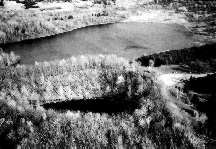|
|
|
|
©2008,
| |
| Clarion
Publications, Inc. All rights reserved | |
The Land Before Time
Western New York's sparkling lakes, lofty hills, deep gorges, raging waterfalls and broad fertile valleys owe their beauty to their geologic origins. |
Kettle hole in Mendon Ponds park in Monroe County |
The abundance of fossilized corals in some regional rock formations confirms that most of Western New York was once covered by a warm, shallow sea. Great quantities of sand and silt, eroded off high eastern mountains over millions of years and squeezed under millions of tons of pressure, developed into sandstone and shale. Abundant corals and shelled animals were the basis of sedimentary rock, the bedrock that lies beneath the region's pastoral scenes. Two million years ago, the snow and ice that had been accumulating in monstrous quantities in the northern hemisphere became, in some places, two miles thick; the tremendous pressure of its weight caused the ice to flow, forming a massive continental ice sheet. During the Ice Age, glaciers invaded all but a small area of New York state. Due to long-term temperature changes, the southern edge of this glacier retreated and advanced several times, scraping, pushing and dragging huge volumes of rock and soil. Stream valleys deepened; others filled with glacial debris. Colossal boulders were picked up and deposited many miles away. Glacial runoff streams deposited piles of smaller, sorted sentiments like sand and gravel. Mounds of glacial debris called drumlins have a characteristic steep north slope and gentle south slope, and are common in the northern Finger Lakes region. Eskers, kames and kettle holes are other glacial formations that can be explored and studied at Mendon Ponds Park in southeastern Monroe County. Western New York's sparkling lakes, lofty hills, deep gorges, raging waterfalls and broad fertile valleys owe their beauty to their geologic beginnings. The preglacial Genesee River once had two branches that converged in Livingston County and flowed north to join the east-west flowing Ontarian River, whose valley eventually became the Lake Ontario basin. As the Ice Age waned and the glacier retreated, great piles of rock and soil, called moraines, dammed the southern ends of many valleys. Vast amounts of water poured off the melting glacier and collected in these valleys, forming, among others, Western New York's beautiful appendage-like Finger Lakes. Twelve thousand years ago, the Genesee River's northward trek was blocked by the Valley Heads moraine near Portageville, Allegany County, and forced over the rocky Letchworth Plateau, beginning an erosional process that would create the two gorges and broad valley now found in Letchworth State Park. The Rochester gorge and waterfall had similar beginnings. Go on to History |
According to WebCounter you are the
person to seek the Best of the West!
|

